
views
- Purchasing your necklace directly from a well-established Native American artist is the best way to ensure you acquire an authentic squash blossom necklace.
- Look on the back of a necklace for a silversmith’s signature, which should tell you who smithed the necklace.
- If a magnet sticks to the necklace, it’s made of silver plating; authentic squash blossom necklaces should be sterling silver.
- Look underneath the turquoise stones for stamping marks, which indicates the necklace is counterfeit.
Checking for Proof of Craftsmanship

Purchase squash blossom necklaces directly from artists or dealers. While it may be tempting to shop for ornate, handmade jewelry on an auction site, you could end up getting ripped off. To drastically lower your chances of purchasing a counterfeit necklace, only do business with established jewelry dealers or the artisans themselves. If you’d like to double-check the legitimacy of the artist, check an online registry that lists all established businesses and artists who produce and sell Native American jewelry in America. You can find an in-depth listing here: https://www.doi.gov/iacb/state-and-country-listings. You’re more likely to find legitimate artists and businesses in the American Southwest, like New Mexico.Did you know? Squash blossom necklaces have a lot of notable components. Many are made with sterling silver beads, as well as inlaid turquoise stones. The most notable feature of the necklace is the central, curved pendant, which is known as the Naja symbol.

Search the back of the necklace for a silversmith’s signature. Turn the squash bottom necklace over to examine the underside. While these necklaces are made with a variety of beads, trinkets, and a central pendant, you might be able to find an engraved signature, or “hallmark,” on the piece. If you’re purchasing a necklace from a separate dealer or business, ask an experienced sales associate for more information on the artisan who created the piece. Modern, 20th or 21st century necklaces may have “SS” or “sterling” engraved on the back of the jewelry piece, which indicates the legitimacy of the necklace.
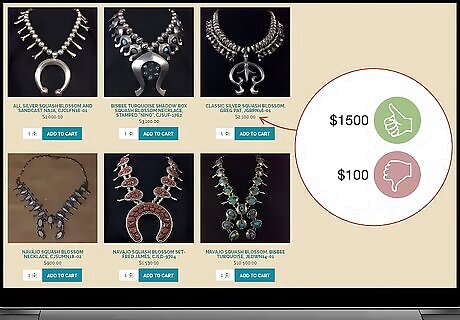
Examine the price tag to see if cost is suspiciously low. Note that many handmade, authentic squash blossom necklace sets are easily worth $1,500, with individual squash blossom pendants being worth over $300. If a seller offers you a necklace for a low price, like $100, you can safely assume that the product is a counterfeit. If the price looks too good to be true, then it probably is. Consider asking the seller if they’ve sold a lot of squash blossom necklaces recently. If the seller is offering these pieces on a frequent, weekly basis, they probably aren’t authentic, as genuine necklaces are ornate and take a lot of time to produce.
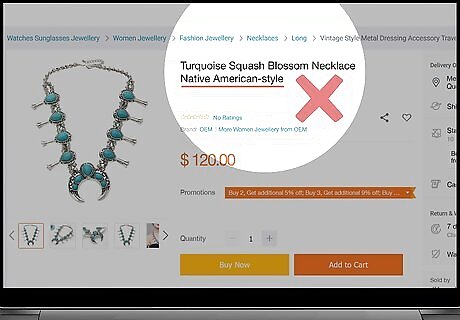
See if the word “style” is used in the product description. Read over the specific listing name for the necklace and see if it’s labeled as “Indian-” or “Native American-style.” Since American law forbids non-Native sellers from using terms like “Native American,” “Indian,” “Navajo,” or other tribe names to describe their listings, many counterfeit necklaces will be described as an “Indian-style” jewelry piece. If you see this label, note that the product isn’t authentic. It’s illegal for non-Native artisans and craft businesses to sell jewelry and crafts with tribal labels. If you believe that an independent business is selling fake squash blossom necklaces (or any kind of Native craft), call the Indian Arts and Crafts Board at 1-888-278-3253.
Studying the Quality of the Necklace
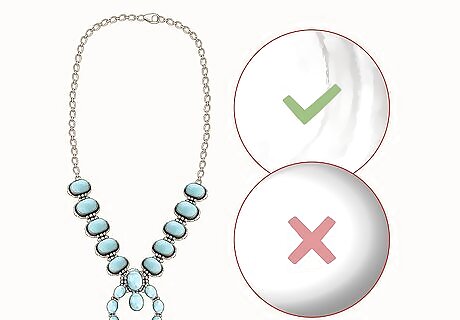
Search for signs of wear on vintage necklaces. Examine the individual beads, squash blossoms, stones, and pendant that make up the squash blossom necklace. If you’re looking to invest in a vintage piece, look for signs of scuffing, scratching, and overall tarnishing on the different elements of the necklace. If a necklace listing claims to be vintage, note that the item shouldn’t look shiny or gently-used. If a squash blossom necklace is from the 19th century, it will definitely show signs of wear and tarnish.

Use a small magnet to see if the necklace is made with sterling silver. Place a small magnet near the edge of the metal jewelry. Wait a few seconds to see if the magnet sticks to the necklace, or if nothing happens. As a general rule of thumb, note that sterling silver isn’t magnetic and won’t stick. If the magnet does stick to the jewelry, you can assume that the necklace was made with silver plating, which does react to magnets. Most modern squash blossom necklaces are made with sterling silver. While a silver-plated piece of jewelry isn’t necessarily a fake, it could be a sign of a counterfeit item. Silver plating usually includes nickel, which causes the plating to stick to magnets. Vintage necklaces might be made with silver ingots, which are made from melted coins and slugs.
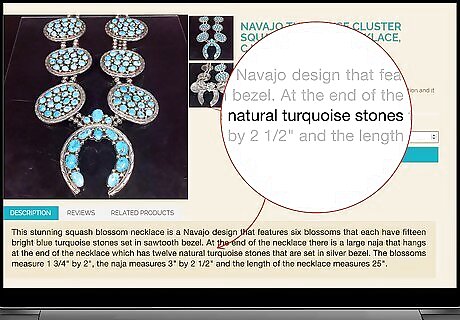
Check the product description to see if the inlaid turquoise is natural. Read the product description to see if the necklace contains stabilized or natural turquoise stones. Note that stabilized stones are adjusted so they can be more sturdy in a necklace, while natural turquoise stones haven’t been altered at all. Most authentic squash blossom necklaces contain natural turquoise, as opposed to the stabilized variety. American law requires that sellers state what kind of turquoise is in their jewelry. While there isn’t an easy test that determines the authenticity of turquoise, the item description might be a good indicator. For instance, “blocks” of turquoise tend to be fake.Did you know? Original, 19th and early 20th century Navajo squash blossom necklaces didn’t have a lot of turquoise, and were made with silver beads and squash blossom components. The Zuni tribe added more turquoise stones to the jewelry, which is why modern squash blossom necklaces contain so many.
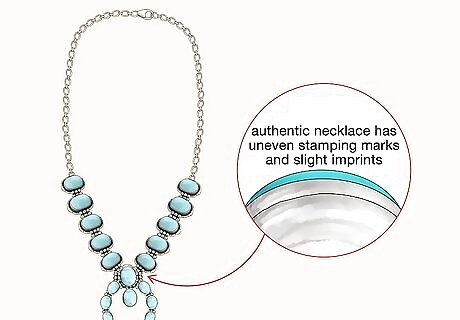
Examine the underside of the necklace to look for stamping marks. Turn the piece of jewelry over to see if you can find any mechanical marks or grooves beneath the turquoise stones. If you see any consistent grooves or markings beneath any inlays, you can assume that the piece was stamped with a machine, making it a counterfeit. If you look carefully along the surface of an authentic necklace, you’ll probably see uneven stamping marks, as well as slight imprints where any hammering was done.
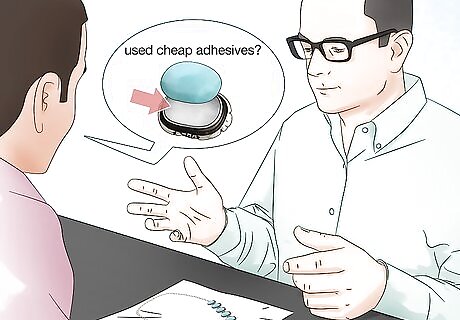
Check the inlaid stones to see if they are secured with an adhesive. Examine the various turquoise stones used in the design of the squash blossom necklace. Note that authentic, handmade necklaces will be held in place with natural materials like sand, while counterfeit jewelry will use cheap adhesives. To be extra thorough, ask a jeweler or experienced dealer to examine the piece for you.




















Comments
0 comment